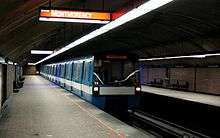MR-73
| MR-73 | |
|---|---|
 An MR-73 train ariving at Lucien-L'Allier station, February 2009 | |
 Refurbished interior of an MR-73 train | |
| In service | 1976–present |
| Manufacturer | Bombardier Transportation |
| Built at | La Pocatière, Quebec |
| Replaced | MR-63 (Rescue) |
| Constructed | 1974–1980 |
| Entered service | June 1976 |
| Refurbishment | 2005–2008 |
| Number built | 423 vehicles in total (105 sets in 3-car formation, 35 sets in complete 9-car formation, except in the Blue Line it have 36 sets in 2-car formation, 18 sets in complete 6-car formation) |
| Formation | 6 or 9 cars per trainset |
| Fleet numbers |
79-501 to 79-782 (motor) 78-001 to 78-141 (trailer) |
| Capacity | 160 passengers per car, 39-40 passengers seated (1440 passengers in complete 9-car set, except in the Blue Line 700 passengers in complete 6-car set) |
| Operator(s) | Société de transport de Montréal |
| Depot(s) | Plateau d'Youville, Saint-Charles, Montmorency, Angrignon, Beaugrand |
| Line(s) served |
Green Line, Yellow Line, Blue Line |
| Specifications | |
| Car body construction | Lightweight steel alloy |
| Width | 2.5 m (8 ft 2 3⁄8 in) |
| Doors | 4 pairs per side |
| Maximum speed | 70–72 km/h (43.5–44.7 mph) |
| Weight | 26,990 kg (59,500 lb) per car (unladen) |
| Traction system | Jeumont chopper |
| Power output | 174 kW (233 hp) |
| Acceleration | 5.2 km/(h⋅s) or 3.2 mph/s |
| Power supply | (?) |
| Train heating | Forced-air ventilation, in-train heater |
| Electric system(s) | 750-volt DC guide bars |
| Current collection method | Contact shoe, side running |
| Bogies | 2 sets per car |
| Braking system(s) | Dynamic brakes |
| Safety system(s) | ATC (ATO) |
| Track gauge |
1,435 mm (4 ft 8 1⁄2 in) standard gauge with a roll way on either side |
The MR-73 (Matériel roulant conçu en 1973) is the second generation of rubber-tired rolling stock used on the Montreal Metro. Since the retirement of the first generation MR-63s, the MR-73 trains are in use on three of Montreal's four Metro lines.
Description
In the early-1970s, the Commission de transport de la Communauté urbaine de Montréal (CTCUM), the predecessor of the STM, identified a need for more rolling stock to serve the crowds expected for the 1976 Summer Olympics as well as for future network expansions. Although the design of what was to later become the MR-73 was completed in 1973, it was only in 1974 that the CTCUM formally awarded the MR-73 contract to the fledgling Bombardier Transportation.[1] 423 MR-73 cars were manufactured at Bombardier's La Pocatière plant between 1974 and 1980 and the first units entered service in 1976. The MR-73's original interior featured orange-and-white seats arranged such that in each third of the train there were two double sets of transverse seating and four single seats near the doors in longitudinal formation,[2][3] which were removed during the 2005–2008 refurbishments and the seating arrangement subsequently modified.
The MR-73 cars can be identified by rectangular cab headlights, side vents, blue and dark orange interiors, and 174 kW (233 hp) traction motors that growl while accelerating, producing a unique three-note sound signature when the train pulls out of a station. The Mean Distance Between Failures (MDBF) for the MR-73 exceeds 200,000 mi (322,000 km) in 2004.
The initial rate of acceleration of the MR-73 model is 1.43 m/s2 (4.7 ft/s2) (5.2 km/(h⋅s) or 3.2 mph/s). The three-note sound is produced by traction motor control equipment called a "current chopper", which is used to control and power the motors on the train in stages without incurring a power surge. It does this by modulating the current in 5 consecutive stages (90, 120, 180, 240 and 360 Hz), the latter 3 being normally audible. A prototype for the current chopper was built by the Canron company using a Jeumont original design in the early 1970s on an MR-63 train. Two of the three elements of this "Jeumont Train" are operated on the Green Line among rheostatic-started MR-63s. One is much louder than the other. They are the only two to exhibit the whole five-note audible signature in normal operation, even though it is possible to hear them during longer than usual starts on regular MR-73s.
These notes are the same as the first three notes of Aaron Copland's "Fanfare for the Common Man", one of the musical themes for Expo 67, though this is apparently just a coincidence. Some MR-73s originally sported murals of Montreal at the end of the cars; however, these were damaged by vandalism and removed long ago.
The MR-73 has a different electrical braking system than the MR-63 to assist friction braking. The MR-73's current chopper recuperates energy when in braking mode, turning traction motors into generators and sending a regulated current back into the traction power supply for other trains to use. Electrical braking is most effective when one train draws power while starting while another train at a different location sends power while braking.
Lines serviced
![]()
![]()
![]()
![]()
Formation
| Line # | Colour | Number of trains | Composition | Comments |
|---|---|---|---|---|
| 1 | 30 (270 cars) | {79-xxx} + 78-xxx + {79-xxx} + {79-xxx} + 78-xxx + {79-xxx} + {79-xxx} + 78-xxx + {79-xxx} | The MR-73 and MPM-10 Azur trains, replacing the aging MR-63s. | |
| 2 | None (0 cars) | {79-xxx} + 78-xxx + {79-xxx} + {79-xxx} + 78-xxx + {79-xxx} + {79-xxx} + 78-xxx + {79-xxx} | In this line replaced with by MPM-10 Azur cars. | |
| 4 | 5 (45 cars) | {79-xxx} + 78-xxx + {79-xxx} + {79-xxx} + 78-xxx + {79-xxx} Summer Break: {79-xxx} + 78-xxx + {79-xxx} + {79-xxx} + 78-xxx + {79-xxx} + {79-xxx} + 78-xxx + {79-xxx} |
||
| 5 | 18 (108 cars) | {79-xxx} + 78-xxx + {79-xxx} + {79-xxx} + 78-xxx + {79-xxx} | 3-car since 1986-2002 | |
Modifications and refurbishments
Automated announcements and visual information
In the early-1990s, Alstom Télécité LED visual information screens were added on top of alternating side windows in all MR-73 cars.[4][5][6] Advertisements were displayed, along with information on the weather and upcoming stations. Around the same time automated next-station announcements were introduced on the MR-73 and voiced by Judith Ouimet.[7][8]

Interior refurbishment
From December 2005 until 2008, the MR-73 fleet underwent $40 million in renovations to reconfigure interior seating to increase total car capacity, and install new poles and new panels with a new ergonomic colour scheme that discourages vandalism, decreases motion sickness and promotes aesthetic harmony. The renovations also include an ergonomic full-spectrum lighting system that provides therapeutic anti-depression effects for its passengers. Like the older MR-63 fleet, the MR-73 driver cabs will be modernized and equipped with ergonomic features and digital dashboards.
Closing doors chime
In 2006, an MR-73 train was tested with a 4-beep door chime,[9] and in 2008, another high-pitched chime was tested.[10] However, these chimes were unpopular so in 2010 a three-note sequence which is essentially the same as the first three notes of "Fanfare for the Common Man" was tested, albeit with a voiceover by Michèle Deslauriers saying "Attention, nous fermons les portes" (approximate translation: Attention, we're closing the doors) after the three-note sound was played.[11][12][13] The voiceover was soon removed, however[14], and since 2012, the MR-73s play the three-note sequence whenever the doors are about to close.
References
- ↑ STM company timeline Archived 2009-06-21 at the Wayback Machine.. Société de transport de Montréal. Retrieved 2013-02-13.
- ↑ Montreal Metro- Arriving train at Lionel-Groulx, Orange line. YouTube. May 22, 2006. Retrieved 2013-02-13.
- ↑ Montreal Metro- Blue line from Jean-Talon to De Castelnau. YouTube. May 22, 2006. Retrieved 2013-02-13.
- ↑ Passenger Information on Montréal métro. YouTube. February 21, 2007. Retrieved 2013-02-13.
- ↑ A Ride On An MR-73 With Our Good Friend Alstom Télécité!!. YouTube. May 20, 2010. Retrieved 2013-02-13.
- ↑ Montreal Metro: Service Disruption on Alstom Télécité!. September 14, 2012. Retrieved 2013-02-13.
- ↑ Judith Ouimet, The Voice of the Metro. Metrodemontreal.com. March 12, 2002. Retrieved 2013-02-13.
- ↑ Berri-UQAM by Judith Ouimet. YouTube. September 24, 2006. Retrieved 2013-02-13.
- ↑ Montreal Metro-Closing Doors Chime-MR73 train-1. YouTube. October 14, 2006. Retrieved 2013-02-13.
- ↑ Le métro qui fait Bip Bip. YouTube. March 18, 2008. Retrieved 2013-02-13.
- ↑ Doo-doo-doo immortalized. Blog.fagstein.com. August 9, 2010. Retrieved 2013-02-13.
- ↑ DOU-DOU-DOU «ATTENTION, NOUS FERMONS LES PORTES…». Société de transport de Montréal. August 9, 2010. Retrieved 2013-02-13.
- ↑ Dou dou dou...the Montréal métro's signature sound.mp4. YouTube. September 18, 2010. Retrieved 2013-02-13.
- ↑ MTL Métro: Updated and final version of MR73 closing door chime!. YouTube. October 26, 2011. Retrieved 2013-02-13.
